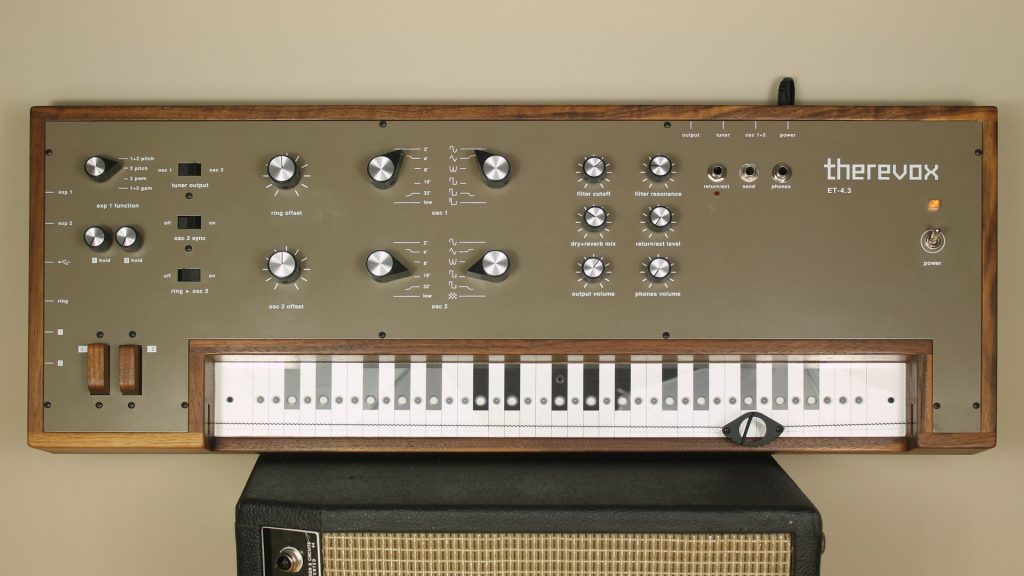
Inspired by the Ondes Martenot (1928) and the Electro-Theremin (1950), the Therevox ET-4 is controlled by moving a finger along a reference keyboard shaped to provide tactile feedback. Dual pressure sensitive intensity keys control the amplitude of the ET-4‘s two independent analogue oscillators. Combined with a low-pass filter, white noise generator and internal spring reverb the ET-4 is an expressive and versatile performance instrument.
Therevox began building custom instruments in 2004. Their first product was the ET-1, a modern version of an Electro-Theremin. The Electro-Theremin was designed by Paul Tanner (1917 – 2013). It was constructed by Bob Whitsell (1930 – 2009). Tanner then played the instrument. It can be heard on the theme song of My Favorite Martian (1963 – 1966) and The Beach Boys’ Good Vibrations and I just wasn’t made for these times (both, 1966) .
In 2008 a limited edition of twelve updated ET-3‘s went to musicians and studios in North America and Europe.
In 2012 they released another continuous pitch analog instrument inspired by the Ondes Martenot and early analog synthesizers. This ET-4 is the current model.
- The ET-4.1 is the standard model,
- The ET-4.2 adds an effects loop and some other features
- The ET-4.3 adds MIDI over USB output.
Every ET-4 is individually hand crafted in Tecumseh, Ontario, Canada, “using high quality components and select North American Walnut. With less than 20 made a year the Therevox ET4 is an exclusive instrument. All soldering, calibrating and assembling is also done in the Tecumseh workshop.”
The ET-4.1 is the standard model, the ET-4.2 adds an effects loop and other features and the ET-4.3 also adds MIDI over USB output.
The instruments are designed to be versatile and durable. It has been featured on several albums and film soundtracks. Composer Adam Taylor (1942 – ) used an ET-4.1 to compose the theme and incidental music for The Handmaid’s Tale.
Connections:
The Handmaid’s Tale (1985), written by Margret Atwood (1939 – ), is a futuristic dystopian novel set in a near-future patriarchal, totalitarian, theonomic Republic of Gilead, located somewhere in New England, where the federal United States government has been replaced. Some of the themes taken up in the novel are the subjugated of women and their loss of agency and individuality, the suppression of their reproductive rights, more specifically the subjection of fertile women to child-bearing slavery. More positively, the novel explores the various means by which women resist, attempting to gain individuality and independence.
The television series, based on the novel, consists of six series, developed from 2017. The last season will be shown in 2023. These were made in Toronto, and other locations in Ontario.
Atwood’s partner, from 1973 until his death, was Graham Gibson (1935 – 2019). Together, they had one daughter. Gibson was particularly noted for his interest in birds, having written The Bedside Book of Birds (2005) and The Bedside Book of Beasts (2009). He was a founder and chair of the Pelee Island Bird Observatory.
Tecumseh and Pelee Island are both locations in Essex County, Ontario. Windsor, where I originated, is also in Essex County, about 17 km from Tecumseh.


During my undergraduate years in Electrical Engineering at the University of Wisconsin-Madison during the early 1960s, every Thursday afternoon there was a free presentation on various topics … a broadening just-for-fun affair. One of these involved electronic music. I recall one classmate saying on is way out the door that it would never amount to anything. I thought, “Don’t be so sure.”
Now it is difficult to find music without any electronic generation/modification, with the exception of certain “purists” in the classical arena.